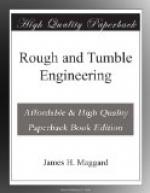I am aware that some engineers claim that the boiler should be blown out at about 5 pounds or I0 pounds pressure, but I believe in taking the common sense view. They will advise you to blow out at a low pressure, and then, as soon as the boiler is cool enough, to wash it thoroughly.
Now, if you must wait till the boiler is cool before washing, why not let it cool with the water in it? Then, when you let the water out, your work is easy, and the moment you begin to force water through it, you will see the dirty water flowing out at the man or hand hole. The dirt is soft and washes very easily; but, if it had dried on the inside of boiler while you were waiting for it to cool, you would find it very difficult to wash off. .
You say I said to force the water through the boiler, and to do this you must use a force pump. No engineer ought to attempt to run an engine without a force pump. It is one of the necessities. You say, can’t you wash out a boiler without a force pump? Oh, yes! You can do it just like some people do business. But I started out to tell you how to keep your boiler clean, and the way to do it is to wash it out, and the way to wash it out is with a good force pump. There are a number of good pumps made, especially for threshing engines. They are fitted to the tank for lifting water for filling, and are fitted with a discharge hose and nozzle.
You will find at the bottom of boiler one or two hand hole plates-if your boiler has a water bottom-if not, they will be found at the bottom of sides of firebox. Take out these hand hole plates. You will also find another plate near the top, on firebox end of boiler; take this out, then open up smoke box door and you will find another hand hole plate or plug near lower row of tubes; take this out, and you are ready for your water works, and you want to use them vigorously; don’t throw in a few buckets of water, but continue to direct the nozzle to every part of the boiler, and don’t stop as long as there is any muddy water flowing at the bottom hand holes. This is the way to clean your boiler, and don’t think that you can be a success as an engineer without this process, and once a week is none too often. If you want satisfactory results from your engine, you must keep a clean boiler, and to keep it clean requires care and labor. If you neglect it you can expect trouble. If you blow out your boiler hot, or if the mud and slush bakes on the tubes, there is soon a scale formed on the tubes, which decreases the boiler’s evaporating capacity. You, therefore, in order to make sufficient amount of steam, must increase the amount of fuel, which of itself is a source of expense, to say nothing of extra labor and the danger of causing the tubes to leak from the increased heat you must produce in the firebox in order to make steam sufficient to do the work.
You must not expect economy of fuel, and keep a dirty boiler, and don’t condemn a boiler because of hard firing until you know it is clean, and don’t say it is clean when it can be shown to be half full of mud.




